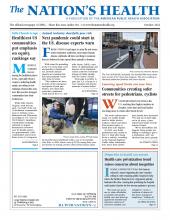
Photo by RyanOverman, courtesy iStockphoto
You probably remember the first day you were allowed to drive. Being handed a license with your name and picture on it brought excitement and freedom. But it also brought a huge responsibility.
Sadly, tens of thousands of preventable car crashes happen every day in the U.S., and dozens of people lose their lives. Safety issues such as speeding and distracted and impaired driving are major contributing factors.
“Driving is a life skill, and from the age of 16 through the rest of your life, it’s probably the biggest skill that affects your life and everything else you do,” says Michael Belcuore, manager of driver education and operations for the American Automobile Association’s AAA Club Alliance.
“But it also can be the most dangerous skill that the average person does throughout their lifetime,” he says.
Driving demands your full attention. The National Highway Transportation Safety Administration says that texting is the most serious distraction among U.S. drivers. Sending or reading a text message takes your eyes off the road for five seconds. At 55 mph, that’s like driving the length of an entire football field with your eyes closed. Some studies put texting while driving in the same category as driving while drunk.
Preventing and avoiding crashes while driving — sometimes called “defensive driving” — and being prepared on the road for whatever may happen, can save your life and the lives of other road users. Wherever you drive throughout the U.S., Belcuore’s message is the same: Be prepared, be present and be ready to react and be safe.
From teens preparing to get their license to seniors who’ve been driving for decades and want a refresher, Belcuore teaches his students to “READ” the road, an easy-to-remember acronym to help focus when you’re behind the wheel.
R: Right speed for right now Speed is one of the important things a driver controls, and often it’s the top cause of crashes. Be ready to slow down.
“You need to be traveling at the right speed,” Belcuore says. “If there’s something out there causing a hazard on the roadway, it means adjusting your speed and picking the right speed for now.”
E: Eyes up, brain on Be present when you’re driving. Distracted driving is a problem everywhere and the leading cause of car crashes. Make sure your eyes are on the road and your brain is present and not distracted by texts, music, your GPS or other passengers in the car. Don’t multi-task while you’re driving — and that includes eating. If you feel sleepy, drive to a safe spot, park the car and take a nap.
A: Anticipate another vehicle’s move Remember that the person driving their car next to you may be a hazard. If you’re prepared for that, you’re going to be a better defensive driver.
“Anticipate their next move, be ready and be thinking about what they can do and what they may do,” Belcuore says.
D: Donut of space around you Not to be confused with the chocolate variety, this type of donut refers to space. Make sure you have space on all sides of your vehicle, to your front and your back.
“That way, if something does go wrong, you have somewhere to go,” Belcuore said. “That may be off the road, it may be into a median or onto a shoulder or something like that.”
Having a donut also means that you’re not following the vehicle in front of you too closely. Always follow the three-second rule.
“A good following distance is three seconds behind the car in front of you, and it’s easy to do,” he says. “Simply pick something stationary on the road. When the car in front of you passes, just count one-1,000, two-1,000, three-1,000. If you hit three-1,000, you’re at least at a good distance behind the car in front of you.”
It’s also important to make sure your mirrors are set correctly and that you are eliminating as much of the side blind spot as you can.
If your car is new, make sure you know the technology and what it does and how it can help you. Technology doesn’t drive the car for you, but if it’s used correctly, it can definitely help you stay safe and help you drive a little bit more safely on the road. But technology can never replace that very quick and easy glance over your shoulder when changing lanes, Belcuore says.
>> For more safe driving tips, visit www.nhtsa.gov
- Copyright The Nation’s Health, American Public Health Association









